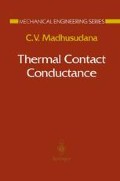Abstract
Microscopic and macroscopic irregularities are present in all practical solid surfaces. Surface roughness is a measure of the microscopic irregularity, whereas the macroscopic errors of form include flatness deviations, waviness and, for cylindrical surfaces, out-of-roundness. Two solid surfaces apparently in contact, therefore, touch each other only at a few individual spots (Fig. 1.1). Even at relatively high contact pressures of the order of 10 MPa, the actual area of contact for most metallic surfaces is only about 1 to 2% of the nominal contact area (see, e.g., Bowden and Tabor, 1950). Since the heat flow lines are constrained to flow through the sparsely spaced actual contact spots, there exists an additional resistance to heat flow at a joint. This resistance manifests itself as a sudden temperature drop at the interface.
Access this chapter
Tax calculation will be finalised at checkout
Purchases are for personal use only
Preview
Unable to display preview. Download preview PDF.
References
Asensio, M.C., Seyed-Yagoobi, J., and Fletcher, LS. (1993). Thermal Contact Conductance of a Moist Paper Handsheet/Metal Interface for Paper Drying Applications. Trans ASME, Heat Transfer, 115:1051–1053.
Attia, M.H., and Kops, L. (1980). Importance of Contact Pressure Distribution on Heat Transfer in Structural Joints of Machine Tools. Trans ASME, J Eng Ind, 102:159–167.
Attia, M.H., and Osman, M.O.M. (1988). Thermal Response of Metallic Moulds to Thermoelastic Interaction at Its Mould Inner Boundary. Thermal Aspects in Manufacturing, ASME, PED, 30:63–76.
Barzelay, M.E., Tong, K.N., and Hollo, C. (1954). Thermal Conductance of Contacts in Aircraft Joints. US Natl Adv Comm Aeronautics. Washington, DC.
Bowden, F.P., and Tabor, D. (1950). The Friction and Lubrication of Solids. Oxford University Press, London, pp. 20–32.
Burton, R.A., and Burton, R.G. (1991). Cooperative Interactions of Asperities in the Thermotribology of Sliding Contacts IEEE Trans, Components, Hybrids, pp. 23–25.
Childres, W.S., and Peterson, G.P. (1989). Quantification of Thermal Contact Conductance in Electronic Packages. IEEE Trans, Components, Hybrids, pp. 717–723.
Dean, R.A. (1962). Thermal Contact Conductance Between UO2 and Zircaloy-2 Westinghouse Electric Corporation, Report CVNA-127 Pittsburgh, PA.
Fitch, J.S. (1990). A One-Dimensional Thermal Model for the Vax 9000 Multi-Chip Units. Am Soc Mech Eng, 153:59–64.
Fletcher, L.S. (1973). Thermal Control Materials for Spacecraft Systems. 10th Int Symp Space Technol Sci, Tokyo, pp. 579–586.
Fletcher, L.S. (1988). Recent Developments in Contact Conductance Heat Transfer. Trans ASME, J Heat Transfer, 110:1059–1070.
Fletcher, L.S. (1990). A Review of Thermal Enhancement Techniques for Electronic Systems IEEE Trans, Components, Hybrids, Manuf Technol, 13(4): 1012–1021.
Im, Y.T., and Altan, T. (1988). Heat Generation and Transfer in Metal Forming: Recent Developments. Thermal Aspects in Manufacturing, ASME, PED, 30:77–88.
Kennedy, F.E., Jr. (1984). Thermal and Thermomechanical Effects in Dry Sliding. Wear, 100:453–476.
Kraus, A.D., and Bar-Cohen, A. (1983). Thermal Analysis and Control of Electronic Equipment. McGraw-Hill, New York, pp. 199–214.
Lavine, A.S., and Jen, T.-C. (1989). Thermal Aspects of Grinding: Heat Transfer to Workpiece, Wheel and Fluid, J Heat Transfer, 123:267–274.
Madhusudana, C.V., and Fletcher, L.S. (1986). Contact Heat Transfer—The Last Decade, AIAA J, 24(3):510–523.
Madhusudana, C.V., Peterson, G.P., and Fletcher, L.S. (1988). Effect of Non-Uniform Pressures on the Thermal Conductance in Bolted and Riveted Joints, Am Soc Mech Eng, 104:57–67.
Mikeseil, R.P., and Scott, R.B. (1956). Heat Conduction Through Insulating Supports in Very Low Temperature Equipment. J Res, US Natl Bureau Standards, 57(6): 371–378.
Reiss, H. (1981). An Evacuated Powder Insulation for a High Temperature Na/S-Battery. AIAA Paper 81–1107, New York.
Scott, A.W. (1974). Cooling of Electronic Equipment. John Wiley, New York, pp. 1–43.
Snaith, B., Probert, S.D., and O’Callaghan, P.W. (1986). Thermal Resistance of Pressed Contacts. Appl Energy, 22:31–84.
Taborek, J. (1987). Bond Resistance and Design Temperatures for High-Finned Tubes—A Reappraisal Heat Transfer Eng, 8(2):26–34.
Tummala, R.R., and Rymaszewski, E.J. (eds.). (1989). Microelectronics Paackaging Handbook. Van Nostrand Reinhold, New York, pp. 211–213.
Williams, A. (1968). Heat Transfer Across Metallic Joints Inst Eng (Australia) Mech Chem Eng Trans, 4:247–254.
Wong, H.Y. (1968). A Survey of Thermal Conductance of Metallic Contacts. Aeronautical Research Council, CIP No. 973, London.
Wood, R.A., Sheffield, J.W., and Sauer, HJ., Jr. (1987a). Thermal Contact Conductance of Finned Tubes: The Effect of Various Parameters. ASHRAE Trans, 93(2): 798–809.
Wood, R.A., Sheffield, J.W., and Sauer, HJ., Jr. (1987b). Thermal Contact Conductance of Finned Tubes: A Generalized Correlation ASHRAE Trans, 93(2):786–796.
Yu, C.J., Sunderland, J.E., and Poli, C. (1990). Thermal Contact Resistance in Injection Molding. Polym Eng Sci, 30(24):1599–1606.
Author information
Authors and Affiliations
Rights and permissions
Copyright information
© 1996 Springer-Verlag New York Inc.
About this chapter
Cite this chapter
Madhusudana, C.V. (1996). Introduction. In: Thermal Contact Conductance. Mechanical Engineering Series. Springer, New York, NY. https://doi.org/10.1007/978-1-4612-3978-9_1
Download citation
DOI: https://doi.org/10.1007/978-1-4612-3978-9_1
Publisher Name: Springer, New York, NY
Print ISBN: 978-1-4612-8457-4
Online ISBN: 978-1-4612-3978-9
eBook Packages: Springer Book Archive

